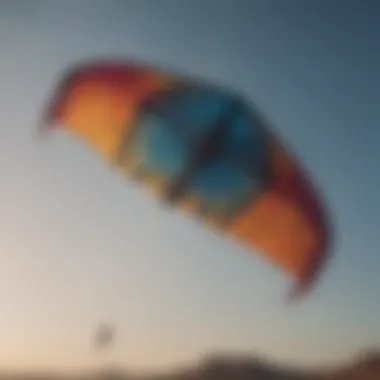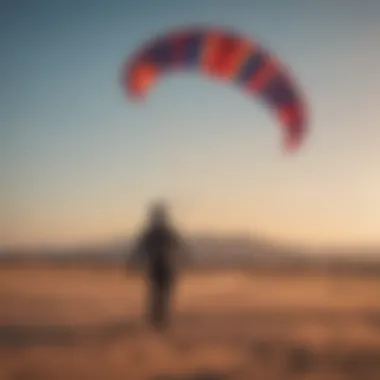Exploring the Duotone 12m Kite: A Comprehensive Guide


Intro
The Duotone 12m kite is a focal point for kiteboarding enthusiasts, offering a blend of performance, design, and user satisfaction. This comprehensive guide examines its various aspects. The primary aim is to inform both novices and experts about this significant piece of equipment. Understanding the technical specifications and performance attributes of the Duotone 12m kite is crucial for maximizing enjoyment while kiteboarding.
This article will explore the design and functionality of the kite, alongside important safety considerations and maintenance practices. It will also provide insights into choosing the right kite for different conditions. This knowledge is vital for anyone looking to deepen their engagement with kiteboarding.
The History of the Sport
Origin and Evolution
Kiteboarding has a rich history that can be traced back to ancient times. Early kites were used for various purposes, including fishing and military applications. However, kiteboarding as we know it began evolving in the late 20th century. The sport gained traction in the 1990s, thanks to innovations in kite designs and materials.
The introduction of inflatable kites transformed the experience, making it more accessible. This led to an increase in participants and a burgeoning community passionate about the sport. The basic premise of using a kite to propel oneself across water took hold quickly.
Milestones and Influences
Several key developments have shaped kiteboarding over the years. Notable milestones include the integration of safety systems that greatly improved rider security. The establishment of competitions around the world has also raised the profile of kiteboarding. Events like the World Kiteboarding League have showcased the talents of riders and inspired many newcomers to join.
Influential figures in the sport have introduced new techniques and encouraged innovation in kite design. Their contributions have created a more vibrant culture surrounding kiteboarding, ensuring its growth continues into the future.
Key Athletes and Pioneers
Figures like Robby Naish and Aaron Hadlow have played significant roles in the development of kiteboarding. Their dedication and skill have pushed the boundaries of what is possible, inspiring others to expand their limits. In addition, numerous riders have contributed to advancing styles and techniques, making the sport increasingly diverse.
Understanding the history of kiteboarding allows enthusiasts to appreciate the foundations upon which the sport stands today.
Techniques and Skills
Basic Techniques for Beginners
For anyone new to kiteboarding, mastering basic techniques is vital for a safe and enjoyable experience. Key skills include:
- Proper kite control
- Understanding wind directions
- Learning to launch and land the kite
- Practicing water re-launch techniques
These foundational skills set the stage for further development in the sport.
Advanced Skills to Acquire
As riders progress, they can explore advanced skills that enhance their performance. Techniques such as jumps, grabs, and rotations expand the rider's repertoire. Each of these skills requires practice and confidence to execute effectively.
Common Mistakes and How to Avoid Them
Riders often make mistakes when starting out. Some of the common issues include:
- Neglecting safety measures
- Failing to assess environmental conditions
- Poor kite positioning
Avoiding these pitfalls enables a more enjoyable and safer kiteboarding experience.
Safety Measures
Essential Safety Gear
Safety should be a priority for all kiteboarders. Important gear includes:
- A properly fitted life jacket
- A helmet for head protection
- Safety releases on the kite
Using quality equipment can significantly reduce risks.
Safety Practices and Procedures
Establishing safety procedures is also necessary. Routines such as pre-ride checks and buddy systems can greatly enhance rider safety. Awareness of weather conditions and other water users is vital.
How to Prepare for Unexpected Situations


No one can predict every situation while kiteboarding. Being prepared helps mitigate risks. Consider carrying a phone in a waterproof pouch, learning self-rescue techniques, and understanding how to respond to equipment failures.
Gear Recommendations
Top Brands and Products
When it comes to kiteboarding equipment, certain names stand out for quality and performance. Notable brands include Duotone, Naish, and Cabrinha. Each brand offers various options that cater to different skill levels and environments.
Budget vs. Premium Options
Riders must consider their budget when selecting gear. While premium products often provide the best performance, many budget-friendly options exist. It is critical to find a balance between quality and cost that matches the rider's needs.
Maintenance and Care for Gear
Proper maintenance extends the life of kiteboarding gear. Rinse kites and lines with fresh water after each session. Inspect equipment regularly for signs of wear or damage. Safe storage when not in use is also essential.
Remember, safety and proper gear maintenance are equally as important as skill development in kiteboarding.
Intro to the Duotone 12m Kite
The Duotone 12m Kite serves as an essential tool within the kiteboarding community. This section aims to lay a strong foundation by examining the kite's significance and its various elements. Understanding the Duotone 12m Kite is crucial for both novice and experienced kiteboarders looking to enhance their abilities and enjoyment on the water.
Overview of Kiteboarding
Kiteboarding combines elements of surfing, sailing, and paragliding. The sport relies heavily on harnessing wind power through a kite. Kiteboarders use the kite to propel themselves across the water, performing tricks, jumps, and maneuvers. The choice of kite can significantly affect performance, safety, and the overall enjoyment of this thrilling activity. Understanding kiteboarding fundamentals helps enthusiasts appreciate the complexities of equipment like the Duotone 12m Kite.
Significance of Kite Size
Kite size is a key factor in determining how well a kite performs under various conditions. The 12m size offers an ideal balance for users, capable of handling a range of wind strengths. A larger kite is great for lighter winds, while a smaller kite performs better in stronger winds. By choosing the right size, a kiteboarder ensures improved lift, control, and stability. This 12m kite is often seen as a versatile option, making it popular among different skill levels.
Choosing the right kite size can greatly impact the performance and enjoyment of kiteboarding.
In summary, the introduction to the Duotone 12m Kite sets the stage for an in-depth look at the kite's technical specifications, performance attributes, and user experiences. Each section builds on this foundation, shedding light on the various aspects that contribute to a kiteboarder's experience.
Technical Specifications
Understanding the technical specifications of the Duotone 12m Kite is crucial for both novice and advanced kiteboarders. These specifications impact the kite's performance, adaptability, and ultimately your experience on the water. The interplay of various technical elements like material composition, wind range, and design features significantly affects how the kite behaves in different conditions. A thorough comprehension of these attributes can help users make informed decisions, optimizing their riding experience.
Material Composition
The material composition of the Duotone 12m Kite is essential to its performance and durability. Typically, the kite is made from high-quality, lightweight fabrics that can withstand harsh conditions. Materials like ripstop nylon or polyester are common choices, known for their strength and water-resistance.
The use of advanced materials helps reduce the overall weight of the kite, which is significant for maneuverability and ease of handling. The lower weight translates directly into better performance in lighter winds, allowing kiteboarders to enjoy more days on the water. Moreover, durable materials also contribute to the kite's lifespan. They resist tearing and abrasion, which is particularly important for anyone who regularly rides in rough conditions.
Wind Range and Performance
The wind range capability of the Duotone 12m Kite is another critical specification. This kite is designed to perform optimally within a specific wind speed range, typically between 10 to 30 knots. Understanding this range is vital for kiteboarders because it influences when and where to use the kite.
In lighter winds, the 12m size allows for adequate lift and support, giving users confidence to ride. In stronger winds, the depower capabilities come into play, making it easier to handle. The kite's design aims to maintain performance across this span. Therefore, riders can expect smooth transitions and effective control, mitigating the risks associated with unpredictable weather conditions.
Design Features
The design features of the Duotone 12m Kite are integral to its functionality. The shape, aspect ratio, and canopy profile all contribute to how the kite interacts with the wind. Typically, a higher aspect ratio enables better upwind performance and increased efficiency. This means less effort is needed to get the desired speed and lift, fostering a more enjoyable experience on the water.
Moreover, innovation in the kite's bridle system and the quality of the seams enhance stability and responsiveness. A well-designed bridle minimizes drag and optimizes the kite's angle of attack, allowing for swift turning and improved performance in various wind scenarios.
In summary, the technical specifications of the Duotone 12m Kite are crucial for understanding its capabilities. From the materials used to the kite's wind range, all elements work together to define how the kite performs. This knowledge is invaluable for those looking to enhance their kiteboarding experiences.
Performance Attributes
The performance attributes of the Duotone 12m kite play a critical role in its usability and effectiveness for kiteboarding. These elements influence how well the kite performs under various conditions, impacting the rider's overall experience. Understanding these attributes helps both novice and advanced kiteboarders make informed decisions while riding and choosing the right kite.
Lift and Hang Time


Lift refers to the kite’s ability to elevate the rider off the water, while hang time is how long a rider can maintain that elevation. A well-designed kite should provide substantial lift, allowing for spectacular jumps and extended periods of airtime. The Duotone 12m kite excels in this aspect, making it ideal for riders who enjoy freestyle tricks and jumping maneuvers.
Good lift is often a combination of the kite's shape and size, along with its angle of attack. The larger surface area of the 12m kite allows for greater lift, which can be advantageous in lighter wind conditions. Hang time is stimulated by how the kite is controlled during jumps. Effective use of the kite's power can maximize both lift and hang time.
"The lift you experience with the Duotone 12m kite is not just about being airborne; it's about how long you stay there and how gracefully you land."
Turning Speed and Responsiveness
Turning speed and responsiveness are critical for maneuvers on the water. A kite that turns quickly allows for rapid direction changes, which is vital during both tricks and navigation on the water. With the Duotone 12m, riders can expect efficient turning capability, aligned with their input. The kite's design focuses on providing immediate feedback when steering, which enhances the overall experience.
The responsiveness of the Duotone 12m kite is influenced by its bridling and control systems. A kite that reacts promptly to commands provides the rider with a sense of confidence and control. It allows for dynamic maneuvers without losing momentum. Advanced riders especially benefit from this trait, as it supports more complex tricks requiring precision.
Depower Capabilities
Depower refers to the kite's ability to reduce its power, which is essential during sudden wind gusts or when navigating tricky conditions. The Duotone 12m kite features excellent depower capabilities, allowing riders to maintain control without losing speed. This can be crucial for safety and performance on the water.
The depower system typically involves adjustments in the kite's angle and tension through the control bar. The ability to depower effectively means riders are not overwhelmed by the kite's power, enabling them to ride comfortably in a variety of conditions. Whether you are new to kiteboarding or a seasoned rider, understanding and utilizing the depower features of the Duotone can significantly enhance your kiteboarding experience.
User Experience
The user experience is a pivotal aspect of any kiteboarding adventure. It encapsulates how riders interact with the Duotone 12m kite, the emotions they feel, and the overall satisfaction derived from its usage. A well-designed kite should not only perform admirably but also instill confidence in its user. Understanding various user experiences provides valuable insights into performance attributes and limitations. This section highlights beginner insights, advanced techniques, and common user feedback to present a comprehensive picture.
Beginner Insights
For beginners, the Duotone 12m kite represents both excitement and challenge. New riders often feel overwhelmed by the kite's power and responsiveness. To facilitate a smoother introduction to kiteboarding, it is essential to focus on key factors:
- Ease of Launch: Beginners appreciate kites that launch with minimal effort. The Duotone 12m kite's design allows for easy handling during launch, reducing anxiety and fostering confidence.
- Stability: A stable kite is crucial for beginners. Users often laud the Duotone 12m for its ability to maintain steady flight even in variable wind conditions, creating a safer learning environment.
- Learning Curve: The kite's responsiveness can be a double-edged sword. While skilled riders may enjoy the quick turns and agility, novices might need time to adapt. It is advisable for beginners to start with small incremental adjustments to harness the kite’s power without feeling overwhelmed.
Advanced Techniques
As riders progress, mastering the advanced functionalities of the Duotone 12m kite becomes vital. Experienced users often delve into specific techniques to extract maximum performance:
- Dynamic Turning: Advanced riders employ intricate body movements to enhance the turning speed of the kite. This technique demands a strong understanding of kite positioning relative to the wind.
- Jumping and Tricks: Kiteboarders looking to jump high or perform tricks must refine their timing and control. The lift and hang time capabilities of the Duotone 12m allow skilled riders to experiment with different aerial maneuvers.
- Depowering Effectively: In changing conditions, advanced kiteboarders must adapt quickly. Knowing how to depower the kite properly can prevent overpowering situations, helping riders maintain control.
Common User Feedback
Common feedback from users sheds light on the overall performance of the Duotone 12m kite, highlighting both strengths and areas of improvement:
- Positive Aspects: Users often praise the kite for its well-balanced performance. Many note that it delivers consistent power and is versatile enough for various conditions, which is essential for different skill levels.
- User Concerns: Some riders express concerns over the kite's weight when wet. Feedback indicates that although it competes well in handling, a lighter alternative could enhance maneuverability during longer sessions.
- Overall Satisfaction: Most assessments conclude that the Duotone 12m kite strikes an impressive balance between performance and ease of use, making it a valued tool for both novices and experienced kiteboarders.
"The Duotone 12m kite truly elevates the riding experience, adapting well to individual levels while providing thrilling challenges along the way."
This intricate exploration of user experiences emphasizes the importance of understanding how different facets influence riders’ interactions with the Duotone 12m kite. From beginners to experts, everyone can harness the kite’s attributes to enhance their kiteboarding journeys.
Safety Considerations
Safety considerations are a crucial aspect of kiteboarding, especially when using the Duotone 12m kite. Understanding safety procedures enhances the experience and minimizes risks. A well-prepared kiteboarder can navigate the challenges of kiteboarding with confidence and skill.
Pre-Flight Checks
Before every session on the water, it is imperative to conduct thorough pre-flight checks. These checks ensure that both the equipment and environmental conditions are optimal for kiteboarding.
Here are some essential elements to include in your pre-flight checks:
- Inspect the kite for any visible damage. Look for tears or abrasions on the fabric.
- Verify line integrity. Check for kinks or frays that might affect performance.
- Ensure that the harness is functioning properly and securely adjusted.
- Confirm that the safety release system is operational and accessible.
- Assess wind conditions and make sure they align with the kite's specifications.
These precautions can significantly reduce the chance of accidents and ensure a successful outing.
Emergency Procedures
Despite thorough checks, emergencies can still occur during kiteboarding. Knowing emergency procedures is crucial for handling unexpected situations with composure.
In the event of an emergency, follow these steps:


- Release the kite. If there's a malfunction, use your quick release system to detach from the kite safely.
- Depower the kite. Pull in on the back lines to reduce the kite's power.
- Focus on your safety. Swim or maneuver towards a safe area, away from other kiteboarders or obstacles.
- Signal for assistance. If needed, alert nearby water sports enthusiasts or lifeguards for help.
Having a well-practiced plan can make all the difference when the unexpected occurs.
Environmental Awareness
An important aspect of safety while kiteboarding involves being aware of the environment. Understanding natural elements can greatly contribute to a safer and more enjoyable session.
Here are a few key points regarding environmental awareness:
- Know the waterway. Familiarize yourself with currents, tides, and any potential hazards in the area where you ride.
- Be mindful of other water users. Respect surfers, swimmers, and other kiteboarders. Maintain safe distances to prevent collisions.
- Adapt to changing weather. Stay alert for shifts in wind direction or intensity. If conditions worsen, it might be best to return to shore.
By remaining vigilant and informed about the surroundings, kiteboarders can significantly enhance their safety and enjoyment on the water.
Maintenance and Care
Proper maintenance and care of the Duotone 12m kite is fundamental for ensuring its longevity and performance. Kiteboarding relies heavily on gear that endures the harsh conditions of wind and water. Regular upkeep not only safeguards your investment but also enhances your overall riding experience. When you consider how often a kite is exposed to elements like saltwater, UV rays, and abrasive sand, the significance of diligent care becomes clear. Regular maintenance also directly impacts safety, reducing the risk of equipment failure while out on the water.
Cleaning Procedures
Cleaning your Duotone 12m kite after each use is essential. A few simple steps can go a long way in maintaining its condition. Begin by rinsing the kite with fresh water, especially after sessions at the beach. Make sure to remove any sand or salt that may cling to the surface. A soft sponge works well for this task. Avoid harsh soaps, as they can deteriorate the material over time. After rinsing, hang the kite to dry completely before folding it for storage.
Tip: Always store the kite in a cool, shaded area to prevent UV damage.
Storage Recommendations
The way you store your Duotone 12m kite is equally important. Once clean and dry, fold the kite properly to prevent creases. Each fold should be smooth, avoiding sharp angles. Storing the kite in a breathable bag avoids moisture build-up, which can lead to mildew. Ideally, keep it in a dry location away from direct sunlight. Extreme temperatures can also affect the kite's material, so be mindful of this when choosing a storage spot.
Repair Techniques
Kites can suffer from wear and tear, especially after multiple uses. It's advisable to be prepared with basic repair techniques. Familiarize yourself with the kite's material; a common issue is minor tears. For this, a repair kit that includes patches and adhesive is often essential. Clean the tear area before applying any patch, ensuring a smooth surface for adhesion. After fixing, allow adequate time for the patch to cure. Regular checks for damage can identify issues before they worsen, helping you avoid costly repairs and ensuring safe performance.
In summary, consistent attention to maintenance and care for the Duotone 12m kite enhances both its lifespan and your enjoyment. By following correct cleaning procedures, ensuring proper storage, and executing timely repairs, you set yourself up for many successful outings on the water.
Choosing the Right Kite
Selecting the appropriate kite is crucial for an enjoyable kiteboarding experience. A kite that aligns with the rider’s skill level, the prevailing weather and wind conditions, and personal preferences can greatly affect performance and safety. Thus, understanding these elements is essential for any kiteboarder aiming to maximize their time on the water.
Evaluating Skill Level
The first factor to consider is skill level. Novice riders should look for kites that are easier to handle. These kites generally have more stability, allowing beginners to learn fundamental skills without overwhelming them. On the other hand, advanced riders may seek kites that offer higher performance features like increased speed and agility. For instance, the Duotone 12m kite offers versatile performance, but its handling characteristics can be challenging for those just starting. A rider must consider their experience while choosing between a freeride kite for relaxed cruising or a more aggressive model for tricks and jumps.
Weather and Wind Conditions
Next, understanding the weather and wind conditions is vital. Different kites perform best under various wind speeds and conditions. A 12m kite is often ideal for moderate wind conditions, known for offering substantial lift without excessive power. However, in strong winds, a smaller kite will provide better control and reduced risks of overpowered sessions. Riders need to check forecasted wind speeds and consider local weather patterns. It's essential to assess not only average conditions but also sudden weather changes that might occur during a session.
Personal Preferences
Personal preferences complete the trio of considerations. Factors such as riding style, comfort, and intended use play significant roles in kite selection. Some riders may prefer a kite that excels in freestyle maneuvers, while others might look for one that enhances light wind performance. These preferences often lead to different sensations when riding, influencing overall enjoyment and functional performance. Achieving harmony between the rider’s needs and the kite’s capabilities can elevate the kiteboarding experience.
"Selecting the right kite requires meticulous evaluation of skill level, weather conditions, and personal preferences to ensure a rewarding kiteboarding adventure."
In summary, choosing the right kite goes beyond mere aesthetics or brand loyalty. It requires informed consideration of skill level, environmental factors, and individual riding style to ensure a positive kiteboarding experience.
The End
The conclusion of this guide is essential in summarizing the key elements that have been discussed regarding the Duotone 12m kite. This section not only encapsulates the insights presented throughout but also reinforces the kite's value in the kiteboarding community. Understanding the performance, safety measures, and maintenance can greatly enhance the user experience.
Choosing the right gear is crucial for kiteboarding. With the details provided in this guide, readers can make informed decisions tailored to their specific contexts. This tailored decision-making benefits both novice and experienced kiteboarding practitioners. Whether you seek adventure or improved performance, recognizing the components of your equipment plays a significant role in achieving both safety and enjoyment on the water.
Final Thoughts on the Duotone 12m Kite
The Duotone 12m kite stands out as a pivotal piece of equipment in the kiteboarding experience. Its design meticulously blends performance and stability, making it well-suited for a variety of conditions. Kiteboarders often find that this size kites can handle an expansive wind range, which increases its versatility in changing environments.
User feedback consistently praises its responsiveness and lift capabilities, especially during maneuvers. This aspect alone is vital for those looking to push their limits and explore advanced techniques. As a result, the Duotone 12m often becomes a favorite among those who wish to elevate their kiteboarding skills.
Moreover, the kite's attractive build combines functionality with aesthetics, appealing to enthusiasts who care about the look and feel of their gear.
The Future of Kiteboarding Gear
The evolution of kiteboarding gear is apparent, and the Duotone 12m kite exemplifies this progression. As technology advances, manufacturers are likely to focus on making kites lighter and more durable while improving their performance metrics. Innovations like improved material compositions and aerodynamic designs are anticipated trends.
With rising interest in eco-friendly products, future kites may also see a surge in sustainable materials. Such developments will likely attract environmentally conscious skateboarders. Additionally, the integration of smart technologies could enhance user experience by providing real-time feedback or adjustments based on wind conditions.







